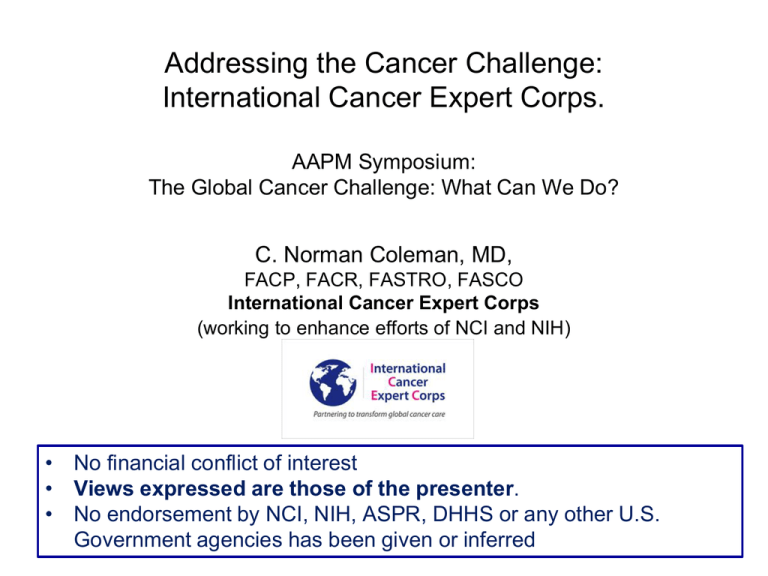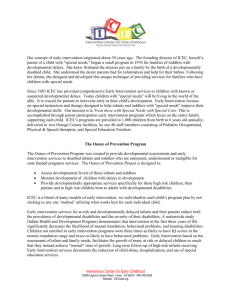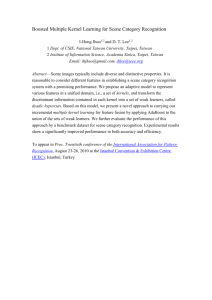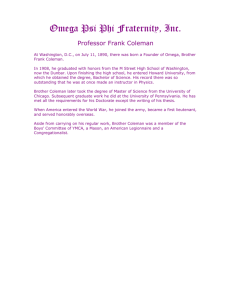Addressing the Cancer Challenge: International Cancer Expert Corps. C. Norman Coleman, MD,
advertisement

Addressing the Cancer Challenge: International Cancer Expert Corps. AAPM Symposium: The Global Cancer Challenge: What Can We Do? C. Norman Coleman, MD, FACP, FACR, FASTRO, FASCO International Cancer Expert Corps (working to enhance efforts of NCI and NIH) • No financial conflict of interest • Views expressed are those of the presenter. • No endorsement by NCI, NIH, ASPR, DHHS or any other U.S. Government agencies has been given or inferred The Global Cancer Challenge: What can we do? Challenges- and opportunities in moving toward alternative technologies 1. Defining the aggregate problems that can be addressed. 2. Unique confluence of issues and expertise- don’t miss a great opportunity! 3. Technology- what we have and alternative technologies for Rx and networking. 4. Cancer care: achieving capacity, capability and credibility 5. Qualified people- recruiting, retaining and sustaining Defining the Problem: WHO Global Burden of Disease http://www.who.int/healthinfo/global_burden_disease/projections/en/index.html NonCommunicable Diseases LMIC cancer death % of global total 2015- 70% 2030- 75% Defining the problem for example 4 Challenges- and opportunities 1. Defining the aggregate problems that can be addressed. – – – It is a public health and NCD problem with very little cancer care being available in LMICs Shortage of radiation therapy equipment in LMICs; radiation therapy is needed for cure and palliation of many cancers Securing sources and public safety necessary 2. Unique confluence of issues, expertise and interestdon’t miss a great opportunity! 3. Technology- what we have and alternative technologies for Rx and networking. 4. Cancer care: achieving capacity, capability and credibility 5. Qualified people- recruiting, retaining and sustaining The state of global health in 2014 J. Sepulveda and C. Murray, Sci 345:1275, 2014 YLL and DAH “Need” “Investment” After the windfall: Plateauing budgets for global health sharpen the focus on what really works M. Enserink, Science 354:1258, 2014 For NCDs The generic challenges in moving to just health care: “Public Health Oncology”* Weak underlying health systems Financing- for infrastructure and staff Transparency Governance (selecting right people) Workforce (manpower)- capacity and capability Incomplete knowledge about diseases, patient/host factors and cost-effective interventions Sustainability “Brain-drain” from resource-poor to resource-rich Top-down approaches from developed nations often not applicable to the local situation *Love, R. Ann Oncol 23:3040- 2012 8 Challenges- and opportunities 1. Defining the aggregate problems that can be addressed. 2. Unique confluence of issues, expertise and interestdon’t miss a great opportunity! – – – – Investment in NCDs must increase globally Evidence-based projects Health care issues are part of a larger set of problems. But there are multiple sectors who now can be involved 3. Technology- what we have and alternative technologies for Rx and networking. 4. Cancer care: achieving capacity, capability and credibility 5. Qualified people- recruiting, retaining and sustaining • Their comparison and mine Advantages of linac Advantages of cobalt • Better quality dosimetry • Security concerns for an active source • Radiation safety Sophisticated treatment Hypofractionation Continuity with advances learned during training Issue of new, refurbished and transition from lower to higher tech • Dependability • Simplicity of repair • Less sophisticated to manage safely • Cost (not include replacement and costs for security) • Easier to learn • Potential (IMRT) Consider mix of equipment and phase in complexity Challenges- and opportunities 1. Defining the aggregate problems that can be addressed. 2. Unique confluence of issues, expertise and interestdon’t miss a great opportunity! 3. Technology- what we have and alternative technologies for Rx and networking. – – – There are technical pros and cons of cobalt and linac Advanced Rx planning and telecommunications may improve Rx in general & enhance collaboration Highly trained personnel may need equipment capable of advanced treatment approaches to remain enthusiastic (staff retention)? 4. Cancer care: achieving capacity, capability and credibility 5. Qualified people- recruiting, retaining and sustaining Academic Activities and Responsibilities 20th Century Research Teachingeducation Clinical care Knowledge MentoringListening Administration Business People Society Public health Fukushima and the future of radiation research. Coleman CN. Radiat Res;179(1):1-8, 2013 Social responsibility MissionService Communication, risks Policygovernment New Activities and Responsibilities 21st Century CANCER HEALTH DISPARITIES Transforming Science, Service, and Society Think globally, mentor locally. CN Coleman and RR Love. Sci Transl Med 2014;6:259 Translating intention into action. Capacity, capability, credibility- sustainable system Challenges- and opportunities 1. Defining the aggregate problems that can be addressed. 2. Unique confluence of issues, expertise and interestdon’t miss a great opportunity! 3. Technology- what we have and alternative technologies for Rx and networking. 4. Cancer care: achieving capacity, capability and credibility – – – – Spectrum of healthcare responsibilities is changing. Issues require broad range of expertise Effective and innovative integration among sectors Built from the ground-up and inside-out (local ideas/people) 5. Qualified people- recruiting, retaining and sustaining Government There are things each can and cannot do (well) Non-Government Organization (NGO) Firewall - outside activity • A US based, NGO • Global from outset • Associate Member: Union International for Cancer Control (UICC) • Partner: Consortium of Universities for Global Health (CUGH) www.iceccancer.org Goals (1) • Build capacity and capability to reduce the burden of cancer through mentoring local champions so they can conduct stage- and region-appropriate protocols. • Mentoring - some on-site visiting, mostly through weekly teleconferencing using carefully crafted “bottom up/top-down” multi-year plans so Centers in LMICs could join the international community of clinical and translational research. Goals (2) • Implementation science: Innovative approaches to cancer health disparities built on person-to-person sustainable mentoring and shared among projects. • Cultural change, big vision and sustainable accomplishments: Multi-national partnership would create a critical mass and spectrum of experts, increase the likelihood of success, allow rapid response to opportunities and demonstrate the value of altruistic service. ICEC functional components Associates in Hubs Experts ICEC Centers Senior associates ICEC- Center Full member ICEC Central Expert panels Junior associates ICEC Center Provisional member International hubs Expert centers AssociatesIn-training ICEC Center Developmental member Domestic hubs Senior Associates Become experts Coleman Front Oncol. 2014; 4: 333. ICEC – what it would uniquely accomplish Multi-national corps of experts, ready for assignment Experts from Hub 1 Hub 1 Coordination and pooling of efforts, protocols, SOPs Innovative approaches: capacity and capabilityto change outcomes ICEC Center 1A & project ICEC Center 1B & project Experts from Hub 2 Hub 2 ICEC Center 2A & project ICEC Center 2B & project Experts from Hub 3 Hub 3 ICEC Center 3A & project ICEC Center 3B & project • • • • • • • Critical mass & international teams. Visible, effective Reduced burden of cancer Shared results and approaches Bona fide academic accomplishment Innovative social and business models Effective place to attract investment Career path for individuals Sustainable overall program in long-term 21 ICEC Expert Panels: Broad spectrum of expertise for complex systems solution • • • • • • • • • • • • Medical Radiation oncologists Medical oncologists Pediatric oncologists Surgical oncologists Nurses Pathologists Radiologists Surgeons - general Surgical subspecialists Pharmacologists Psychologists Public health Science, non-MD Prevention and screening Epidemiologists Medical physicists Technologists Basic & translational scientists Treatment guidelines Statisticians Social scientists Regulatory Affairs specialists Pharmacists Support Educational tools Finance Clinic administration International policy Patient advocacy Economists Social workers Communications Cancer survivors Information tech (IT) Data-management Legal Challenges- and opportunities 1. Defining the aggregate problems that can be addressed. 2. Unique confluence of issues, expertise and interestdon’t miss a great opportunity! 3. Technology- what we have and alternative technologies for Rx and networking. 4. Cancer care: achieving capacity, capability and credibility 5. Qualified people- recruiting, retaining and sustaining – Need new approaches building from various ongoing efforts – International collaboration and exchange of ideas, cultures and science – Local investment – part of community NCD effort – Altruistic service must be recognized, valued and rewarded So, what to consider from a radiation oncologist perspective: (personal opinion) 1. Paradigm shift- mission of improving global care – is not second rate use of professional time – major social/medical healthcare issue 2. Sustainable partnerships – Person-to-person relationships – Single course or periodic visit not sufficient 3. Training, education, research, – joint projects; not top-down solutions 4. Creative solutions to a complex set of problems – Implementation science “It always seems impossible until it's done.” Nelson Mandela Want further yakking? Norm Coleman normcoleman@gmail.com Norm.coleman@icec.org ICEC Website (in evolution) www.iceccancer.org info@iceccancer.org


